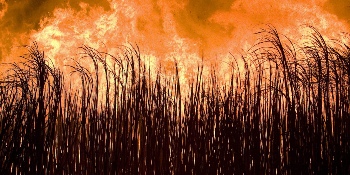Researchers from SEI played a central role in a new study that shows that implementing 14 key air pollution control measures could save millions of lives, slow the pace of near-term climate change and boost agricultural production.

The study, published in the journal Science this week, identifies 14 measures targeting methane and black carbon emissions that could slow global mean warming by approximately 0.5ºC by 2050. The measures could also prevent between 700,000 and 4.7 million premature deaths each year and increase global crop yields by between 30 million and 135 million tonnes per season. The study has been carried out by an international team, including scientists from the Stockholm Environment Institute, the NASA Goddard Institute for Space Studies, the International Institute for Applied Systems Analysis (IIASA), the European Commission’s Joint Research Centre, Scripps Institution of Oceanography, King’s College London, and the Centre for Ecology and Hydrology.
While all regions of the world would benefit, the study estimates that central and northern Asia, southern Africa and the Mediterranean would avoid the most warming; Asia and Africa would avoid the greatest number of premature deaths; and China, India and the US would gain the most from increased crop production, followed by Pakistan and Brazil. Countries in South Asia and the Sahel region of Africa could see considerably reduced disruption to rainfall patterns.
The new research published in Science was led by Dr Drew Shindell of the NASA Goddard Institute for Space Studies in New York City. Drs Johan Kuylenstierna, Lisa Emberson and Kevin Hicks of the Stockholm Environment Institute co-authored the paper, which builds on the recent UNEP/WMO Integrated Assessment of Black Carbon and Tropospheric Ozone report.
| “All 14 measures are based on existing technologies and can be implemented immediately”
Dr Johan Kuylenstierna, SEI |
“All 14 measures are based on existing technologies and can be implemented immediately, so they do not require long development processes. The measures maximize climate benefits but would also have important ‘win-win’ benefits for human health and agriculture”, says Kuylenstierna, Centre Director of the Stockholm Environment Institute in York.
Black carbon – a product of the incomplete combustion of fossil fuels or biomass such as wood or agricultural crop residues – damages human health by entering the lungs and exacerbating a number of respiratory diseases. It also absorbs radiation from the sun causing the atmosphere to warm and rainfall patterns to shift, and reduces the reflectivity of bright surfaces, such as ice and deserts, a process that hastens global warming.
“The motivation for taking action will vary from country to country and region to region. In some, climate change will be the main concern but in others, air quality may well take precedence,” says Hicks.
Methane is a precursor to ground-level or lower atmosphere ozone, a component of health-sapping smog, and is also a potent greenhouse gas. Ground-level ozone at current levels also damages plants and reduces agricultural yields in sensitive areas. “Ground-level ozone is a particular problem in areas such as south Asia which is particularly vulnerable to food insecurity and climate change,” added Emberson.
Black carbon and methane pollutants come from a wide variety of sources and the 14 measures identified in the study have all been successfully applied in different parts of the world. To reduce methane emissions, the key strategies considered in the analysis are: capturing gas that would otherwise escape from coal mines and oil rigs; reducing leakage from long-distance gas pipelines; preventing methane emissions in city landfills; updating city wastewater treatment plants; aerating rice paddies more frequently; and limiting emissions from manure on farms.
Strategies identified to tackle black carbon include installing particle filters in diesel vehicles; keeping high-emitting vehicles off the road; upgrading cook stoves and boilers to cleaner burning types; installing more efficient kilns for brick production; upgrading coke ovens; and banning agricultural burning.
Professor Martin Williams of King’s College London, a co-author of the study and chair of the Executive Body for the Convention on Long-range Transboundary Air Pollution (LRTAP), says: “Measures taken now to reduce carbon dioxide emissions will not have any effect on the global climate for another 40–50 years. We have shown that there are things we can do to begin to mitigate the temperature increases already being seen.”
“The combination of methane and black carbon measures with substantial reductions of carbon dioxide emissions has a high probability of limiting global mean warming to <2ºC during the next 60 years, something which neither set of emissions reductions achieves on its own.”
The research team used sophisticated emission, air quality and climate models (e.g. IIASA GAINS, NASA GISS and ECHAM) to estimate the impact of emissions reductions. The modelling shows that the benefits from the methane reductions would be widespread because methane is evenly distributed throughout the atmosphere. There is high confidence that the methane measures if fully implemented will lead to big benefits for the global climate and agriculture, and relatively smaller benefits for human health, all distributed worldwide.
Action on black carbon is also likely to provide substantial benefits for the global climate, although there is more uncertainty on this compared with the methane measures. However, there is greater certainty that the black carbon measures will bring large regional benefits for human health, lessen disruption to regional rainfall patterns, reduce ice melt in both the Arctic and the Himalayas, and improve regional agricultural yields.
This new research builds on the UNEP/WMO Integrated Assessment of Black Carbon and Tropospheric Ozone report, led by Drew Shindell at NASA and coordinated by researchers at the Stockholm Environment Institute in York.
Further information
Read the article in Science»
SEI press release on the UNEP/WMO report»
For interactive and embeddable country-by-country graphs and maps of the impact of emissions reductions, and a slide show to illustrate and explain the 14 measures involved, visit the NASA website or the NASA Flickr stream.
UNEP’s follow-up report, also coordinated by the Stockholm Environment Institute»
Design and development by Soapbox.

